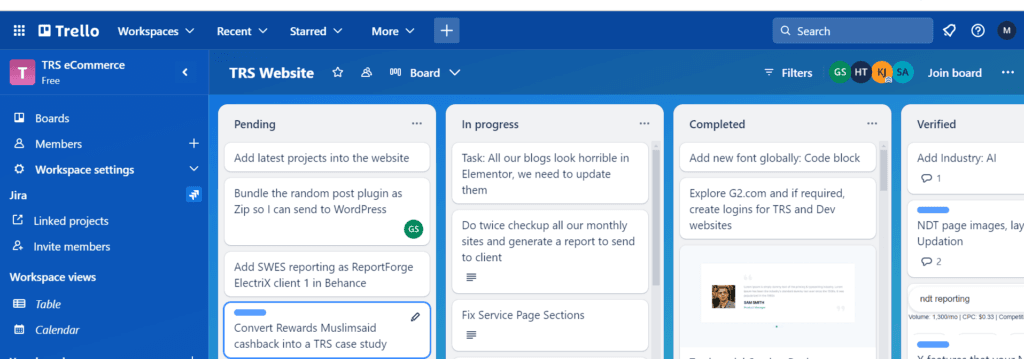
How to manage remote IT Teams: 16 Best Practices

Table of Contents
- Benefits of Remote Teams
- The challanges of managing a remote team
- Communication Barriers
- Lack of Supervision
- Maintaining Team Cohesion
- Technical Issues
- Loneliness
- Work-Life Balance
- Burnout
- Cultural Differences
- Lack of Trust
- Strategies for managing remote IT teams
- Clear Communication
- Leveraging Technology
- Setting Clear Goals and Expectations
- Create well-documented procedures
- Plan for technical difficulties
- Regular Check-Ins
- Providing Continuous Support and Development
- Recognize and Address Burnout Signs
- Provide continuous feedback
- Recognize and reward good work
- Determine outputs, forget about activity
- Building Trust
- Build Inclusive Practices
- Have face-time (even virtually)
- Build a remote culture
- Create a safe place
- Conclusion
- How DevProvider Manages Remote Teams?
Remote work has become increasingly popular in the IT industry, bringing with it both opportunities and challenges. Managing remote IT teams requires a unique approach to ensure productivity, communication, and team cohesion. Here are 15 best practices to help you manage your remote IT teams effectively.
Benefits of Remote Teams
Access to Specialized Skills: Remote IT teams provide access to a pool of experts with diverse skill sets. This is particularly beneficial for IT projects requiring niche expertise.
Scalability: Businesses can scale their teams up or down based on project requirements, ensuring optimal resource utilization. This flexibility helps in adapting to changing business needs without the constraints of physical office space.
Cost-Effective: By leveraging remote talent, companies can reduce recruitment and training costs associated with full-time employees. This approach minimizes overhead expenses related to office space, utilities, and other on-site costs.
Flexibility: Remote IT teams offer the flexibility to engage professionals for short-term projects or long-term collaborations as needed. This adaptability allows companies to meet project demands efficiently and effectively.
Discover: Pros and cons of IT staff Augmentation.
The challanges of managing a remote team
Managing remote teams comes with its own set of challenges that can affect productivity, communication, and team cohesion. Understanding these complexities is the first step in learning how to manage remote teams more effectively. Following are some complexities:
Communication Barriers
Remote work often relies on digital communication tools, which can lead to misunderstandings and miscommunications due to the lack of non-verbal cues and immediate feedback.
Lack of Supervision
Without physical presence, it can be challenging for managers to supervise employees directly, ensuring they stay on task and maintain productivity.
Maintaining Team Cohesion
Building and maintaining a strong team spirit can be difficult when team members are geographically dispersed and have fewer opportunities for spontaneous interactions.
Technical Issues
Remote work depends heavily on technology, and technical problems like poor internet connections or software glitches can disrupt workflows and hinder productivity.
Loneliness
Remote workers can feel isolated without the social interactions that come naturally in a traditional office setting, which can affect their mental well-being and job satisfaction.
Work-Life Balance
Blurring the lines between home and work can make it challenging for remote employees to maintain a healthy work-life balance, leading to overworking or distractions.
Burnout
The pressure to always be available and the difficulty in separating work from personal life can lead to burnout among remote workers.
Cultural Differences
Remote teams often consist of members from different cultural backgrounds, which can lead to misunderstandings and conflicts if not managed carefully.
Lack of Trust
Building and maintaining trust within a remote team can be difficult, as managers may struggle to believe that employees are working diligently, and employees may feel micromanaged.
Strategies for managing remote IT teams
Clear Communication
Effective communication is essential to manage remote teams successfully. Establish clear channels of communication and ensure regular updates. Tools like Slack, Microsoft Teams, and Zoom can facilitate seamless communication.
- Regular Check-ins: Schedule daily or weekly meetings to discuss project progress, address issues, and align on goals.
- Documentation: Maintain comprehensive documentation of processes, project timelines, and responsibilities to ensure everyone is on the same page.
Leveraging Technology
Invest in the right tools and technologies to enhance collaboration and productivity.
- Project Management Tools: Use tools like Trello, Asana, or Jira to track project progress, assign tasks, and manage deadlines.

- Collaboration Tools: Implement tools such as Google Workspace, Zoho Workplace or Microsoft 365 to enable real-time collaboration on documents and presentations
- Time Tracking: Utilize time tracking software like Clcokify, Toggl or Harvest to monitor work hours and productivity.
Setting Clear Goals and Expectations
Define clear goals and expectations from the outset to ensure alignment and accountability.
- SMART Goals: Set Specific, Measurable, Achievable, Relevant, and Time-bound (SMART) goals to provide clear direction.
- Performance Metrics: Establish key performance indicators (KPIs) to measure progress and identify areas for improvement.
Create well-documented procedures
Develop and maintain comprehensive documentation for processes, workflows, and responsibilities. Ensure that all team members have access to this information, which should be regularly updated.
Plan for technical difficulties
Anticipate potential technical issues by having backup plans and resources in place. Ensure team members have access to troubleshooting guides and support channels. Regularly test and update technology tools, and provide training on how to handle common problems.
Regular Check-Ins
Regularly check in with team members to inquire about any problems they are facing and address their concerns promptly.
Providing Continuous Support and Development
Support the professional growth of your remote IT team through continuous learning and development opportunities.
- Training Programs: Offer access to online courses, webinars, and workshops to enhance skills and knowledge.
- Mentorship: Implement mentorship programs to provide guidance and support from experienced professionals.
Promote Social Interaction
- Encourage casual interactions among team members.
- Create virtual watercooler channels for non-work-related chats.
Set Boundaries
- Encourage employees to set clear work hours and respect their personal time.
- Promote the use of “Do Not Disturb” features during non-working hours.
Allow for flexibility
Encourage flexible lunch, tea, and prayer breaks to accommodate varying personal routines and time zones. Allow team members to take breaks at times that best suit their work patterns, including time for prayer if needed. This flexibility helps maintain productivity, supports a balanced work-life integration, and promotes a healthier remote work environment.
Recognize and Address Burnout Signs
- Be attentive to signs of burnout, such as decreased productivity or engagement.
- Offer support and adjustments to workloads when necessary.
Provide continuous feedback
Maintain open lines of communication by regularly providing constructive feedback. Schedule one-on-one meetings to discuss performance, acknowledge achievements, and identify areas for improvement. This ongoing dialogue helps align team goals and fosters personal and professional growth.
Recognize and reward good work
Recognition and rewards play a crucial role in maintaining motivation and productivity among remote IT teams. By acknowledging the efforts and achievements of team members, you can foster a positive work environment, boost morale, and encourage continuous high performance.
Importance of Recognition and Rewards
Boosts Morale: Regular recognition helps in maintaining high spirits and enthusiasm among team members, making them feel valued and appreciated.
Increases Engagement: When employees know their efforts are noticed, they are more likely to stay engaged and committed to their work.
Enhances Productivity: Recognized employees are often more motivated to maintain or improve their performance, leading to higher productivity levels.
Promotes Loyalty: Recognition fosters a sense of belonging and loyalty, reducing turnover rates and retaining top talent.
Determine outputs, forget about activity
Emphasizes evaluating performance based on the effectiveness and impact of the end product rather than the process or methods used. This approach encourages efficiency and prioritizes achieving goals over getting bogged down in the details of daily activities.
Building Trust
Fostering a culture of trust and engagement is crucial for remote teams.
- Transparency: Be transparent about project goals, expectations, and performance metrics.
- Recognition: Recognize and reward the contributions of remote team members to boost morale and motivation.
- Team Building: Organize virtual team-building activities to strengthen relationships and foster a sense of belonging.
Build Inclusive Practices
Acknowledge and accommodate the different time zones of your remote team members. Schedule meetings and deadlines that consider everyone’s availability, and use tools that help coordinate across time zones, such as shared calendars and time zone converters.Be mindful of cultural holidays and observances. This ensures fair participation and reduces scheduling conflicts.
Have face-time (even virtually)
Prioritize regular virtual face-to-face interactions through video calls to build rapport and strengthen team connections.

Build a remote culture
Develop a strong remote culture by fostering team cohesion through regular virtual team-building activities, shared goals, and consistent communication. Celebrate successes, encourage informal interactions, and promote a sense of community by recognizing individual contributions and creating opportunities for social engagement.
Create a safe place
Foster a supportive and inclusive environment where team members feel comfortable expressing their thoughts and concerns. Implement clear policies against discrimination and harassment, and provide channels for confidential feedback.
Conclusion
Managing remote IT teams through staff augmentation offers significant benefits, including cost savings and access to specialized skills. To effectively manage remote teams, implement clear communication, use the right technologies, build trust, set clear goals, and provide continuous support. These strategies ensure your remote IT team stays productive, engaged, and aligned with business objectives. When managed well, staff augmentation is a powerful tool for navigating remote work complexities and driving business success.
How DevProvider Manages Remote Teams?
At DevProvider, effective remote team management drives our success. We use clear communication, advanced tools like Trello and Clockify, and regular virtual check-ins to track progress and manage deadlines. Trust and transparency, along with recognition of team efforts, maintain high morale. For more information how we manage remote teams or to get in touch, please Contact DevProvider.
Tags: IT Staff Augmentation, manage remote teams, Remote IT Teams, Remote Work Best Practices, Remote Work Challenges, tips for managers, tips to manage teams, Virtual Team Support

